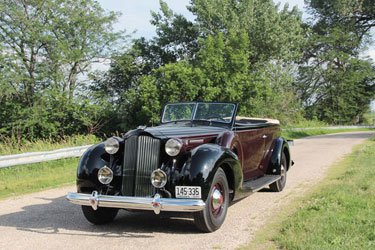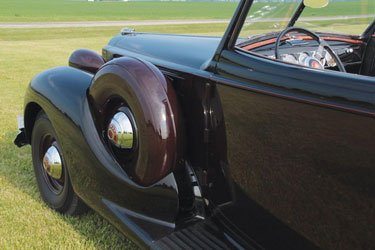Old Cars Weekly profiles a car built to fit a specific customer’s taste back in the days when an individual automobile buyer could make decisions of his own and all of an automobile’s features, equipment, and design were not dictated by a Washington bureaucracy working in cahoots with giant corporations to limit competition and choice.
[A] particular style of car came to be: the “Philadelphia car.†These cars were usually painted black or very dark colors, were fitted with blackwall tires, had some or all of the chrome removed or painted and had logos and emblems removed or painted over. In general, they were understated and rather reserved, and even blacked out to the point of being eccentric and almost sinister. Status was downplayed and there was to be no free advertising of the brand of the car. This even affected the mainstream designs of the luxury automakers; on the very exclusive 1934-1937 Cadillac V-16 models, the Cadillac name can be found nowhere on the outside of the car.
Daniel Bertsch Wentz Jr. of Rydal, Pa., was an executive of the Stonega Coke and Coal Co. and a member of the elite North Philadelphia Family (Wentz, Bertsch, and Leisenring) that controlled extensive coal mining operations in Pennsylvania and West Virginia from the 1860s to the 1960s. In short, he was old money high society and he could afford any car, even in hard times. In 1937 and 1938, the United States was in a recession following the depression, yet Packard had restyled its entire senior line to attract more buyers. Daniel Wentz saw one of the new Packards just after they came out and liked them, but he had his own vision. He went to his local coachbuilder, with whom he had worked before, and discussed his ideas with Enos Derham, owner of Derham Custom Body Corp. of Rosemont, Pa. He asked Enos to design a special convertible victoria on the new Packard Twelve chassis. …
The design retained the Packard front fenders and hood, running boards and rear fenders with modifications. From the cowl back, the body was completely different. The windshield was built with multiple bronze castings with a delicate chrome frame for the glass only, and was raked and veed more than the standard factory Packard windshield, making it lower and sportier.
Indeed, from the cowl back, his convertible bore no resemblance to the cataloged Packard convertible victoria. The entire body was aluminum skin over ash structural wood, and the body lines were formed into the aluminum, not separate pieces. In fact, the rear tub of the car was formed in one piece of aluminum, including the continuous beltline. The doors alone were amazingly designed and built with multiple compound curves from front to back and top to bottom. The beltline tapered through the length of the 4-foot doors, and the upper line, which dropped dramatically from the windshield to the rear quarter made the windshield look even lower. These curves and drops gave the car a sleek and sporty look unlike that of any production cars from 1938.
Derham straightened the front edge of the doors where Packard had curved them, then curved the lower edge and angled the rear edge forward to break up the side of the car with an attractive curve that accentuated the slope of the rear deck. Overall, the design of the doors was very complex and extremely well thought out and executed both in function and in style; the more you look at the doors, the more you appreciate them. This is one of the features that sets this car as a one-off Full Custom body apart from production cars. This intense level of craftsmanship simply couldn’t be achieved within the corporate cost restrictions.
The design utilized the Packard long-wheelbase chassis which allowed a full and comfortable rear seat with plenty of leg room with enough room for a long, sloping rear deck treatment that was quite striking. The other very unusual feature of the design was that of the top and windows. The door windows had no vent windows and the sides were angled to match the rake of the windshield in front and the quarter windows in the rear. Having quarter windows at all was a departure from Packard four-passenger convertibles and made sitting in the rear seat much more pleasant. With the windows down, the car looked longer, lower and much sportier.
Read the whole thing.







Boligat
There is a lot to be said for modern cars, but in terms of sheer beauty, they are pitiful. They have no character whatsoever and they all look the same.
We have a yearly festival in Springfield, MO, when all the old geezers with their old cars show up. Heaven. It’s a delightful few days driving up and down Glenstone Ave rubbing shoulders (figuratively, of course) with the classics. What a trip! I just wish I had the money to do one of my own.
Not quite the same era, but the same idea. I’d love to get my hands on a Corvair just to poke Ralph Nader in the eye.
Please Leave a Comment!